
Heinola is a town and a municipality of 17,838 inhabitants located in the eastern part of the Päijänne Tavastia region, Finland, near the borders of the South Savonia region and the Kymenlaakso region. It is the third largest municipality in the region in terms of population after Lahti and Hollola. The neighbour municipalities of Heinola are Asikkala, Hartola, Iitti, Kouvola, Mäntyharju, Nastola, Pertunmaa and Sysmä.

Hämeenlinna is a city in Finland and the regional capital of Kanta-Häme. It is located in the southern interior of the country and on the shores of Lake Vanajavesi. The population of Hämeenlinna is approximately 68,000, while the sub-region has a population of approximately 94,000. It is the 15th most populous municipality in Finland, and the 14th most populous urban area in the country.

Alavieska is a municipality of Finland. It is located in the province of Oulu and is part of the Northern Ostrobothnia region. The municipality has a population of 2,431 and covers an area of 253.02 square kilometres (97.69 sq mi) of which 1.66 km2 (0.64 sq mi) is water. The population density is 9.67 inhabitants per square kilometre (25.0/sq mi).

Alavus is a town and municipality of Finland. It is located in the province of Western Finland and is part of the Southern Ostrobothnia region, 52 kilometres (32 mi) southeast of Seinäjoki, 138 kilometres (86 mi) north of Tampere and 319 kilometres (198 mi) north of Helsinki. The town has a population of 10,834 and covers an area of 1,151.46 square kilometres (444.58 sq mi) of which 52.31 km2 (20.20 sq mi) is water. The population density is 9.96 inhabitants per square kilometre (25.8/sq mi). Neighbouring municipalities are Alajärvi, Kuortane, Seinäjoki, Virrat and Ähtäri.
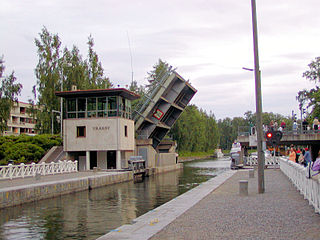
Asikkala is a municipality of Finland. Its seat is in Vääksy, at the shores of the Lake Päijänne. It is located in the province of Southern Finland and is part of the Päijänne Tavastia region. Asikkala's neighboring municipalities are Hämeenlinna, Heinola, Hollola, Lahti, Padasjoki and Sysmä.

Askola is a municipality of Finland. It is located in the Uusimaa region. The municipality has a population of 4,667 and covers an area of 218.03 square kilometres (84.18 sq mi) of which 5.61 km2 (2.17 sq mi) is water. The population density is 21.97 inhabitants per square kilometre (56.9/sq mi). Monninkylä is the largest village of the municipality in terms of population. Neighbouring municipalities are Myrskylä, Mäntsälä, Pornainen, Porvoo and Pukkila.

Aura is a municipality of Finland. The name derives from the river Aura and the plough reminiscent shape of the municipality. The municipality was established in 1917 from parts of Lieto and Pöytyä.

Kouvola is a city in Finland and the administrative capital of Kymenlaakso. It is located in the southeastern interior of the country. The population of Kouvola is approximately 79,000. It is the 12th most populous municipality in Finland, and the 17th most populous urban area in the country.
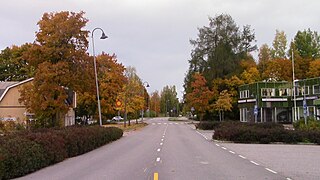
Hausjärvi is a municipality of Finland. Its seat is in Oitti.
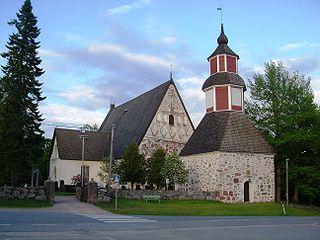
Janakkala is a municipality of Finland. Its administrative centre is in Turenki. Janakkala is located along Highway 3 (E12) in the province of Southern Finland and is part of the Tavastia Proper region. To the south Janakkala shares a boundary with Riihimäki, the northern neighbour being Hämeenlinna. It is 16 kilometres (9.9 mi) from Turenki to Hämeenlinna, 94 kilometres (58 mi) to Tampere, and 96 kilometres (60 mi) to Helsinki.

Jokioinen is a municipality of Finland.

Hämeenkoski is a former municipality of Finland. It was merged to the municipality of Hollola on 1 January 2016.

Kärkölä is a municipality of Finland. It is located in the province of Southern Finland and is part of the Päijänne Tavastia region. The municipality has a population of 4,094 and covers an area of 259.30 square kilometres (100.12 sq mi) of which 2.84 km2 (1.10 sq mi) is water. The population density is 15.96 inhabitants per square kilometre (41.3/sq mi). Its seat is in Järvelä, which is located along the Riihimäki–Lahti railway.

Kärsämäki is a municipality of Finland. It is located in the province of Oulu and is part of the Northern Ostrobothnia region. The municipality has a population of 2,378 and covers an area of 700.91 square kilometres (270.62 sq mi) of which 6.06 km2 (2.34 sq mi) is water. The population density is 3.41 inhabitants per square kilometre (8.8/sq mi). Kärsämäki is a significant road junction where Highway 4 (Helsinki–Oulu–Utsjoki) and Highway 28 (Kokkola–Kajaani) intersect and where Highway 58 leading to Kangasala begins. The distance to the regional capital Oulu is 123 kilometres (76 mi).

Päijät-Häme is a region in Southern Finland south of the lake Päijänne. It borders the regions of Uusimaa, Kanta-Häme, Pirkanmaa, Central Finland, South Savo and Kymenlaakso. The biggest city in the region is Lahti.

Mäntyharju is a municipality of Finland. It is located in the Southern Savonia region, about 40 kilometres (25 mi) southwest of Mikkeli. The municipality has a population of 5,518 (31 October 2024) and covers an area of 1,210.98 square kilometres (467.56 sq mi) of which 229.23 km2 (88.51 sq mi) is water. The coastline is almost 1,520 kilometers (940 mi). The population density is 6.2 inhabitants per km².
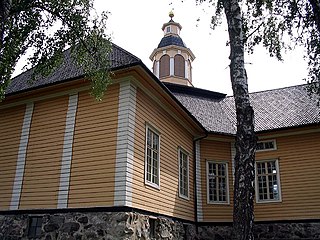
Nastola is a former municipality of Finland. It was merged with the city of Lahti on 1 January 2016.
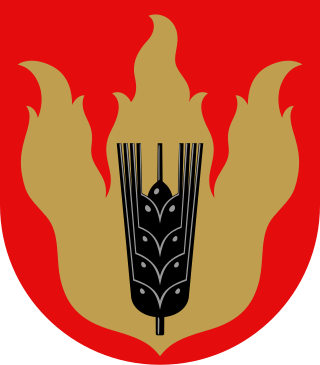
Pertunmaa is a municipality of Finland located in the Southern Savonia region. The municipality has a population of 1,541 and covers an area of 454.20 square kilometres (175.37 sq mi) of which 79.7 km2 (30.8 sq mi) is water. The population density is 4.12 inhabitants per square kilometre (10.7/sq mi). The language of the municipality is Finnish.
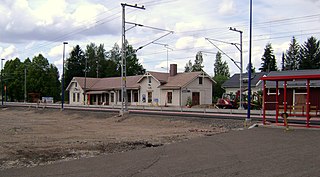
Kausala is a village and administrative center in Iitti municipality in Päijänne Tavastia, Finland. Kausala has a population of 3,775, which makes it the largest village of the municipality in terms of population. The significance of Kausala for the municipality is largely due to its central location along the highway, Finnish national road 12 (Vt12), and the Lahti–Kouvola railway passing through the village. The nearest lakes are Lake Leininselkä and Lake Urajärvi in the northern part of the village.
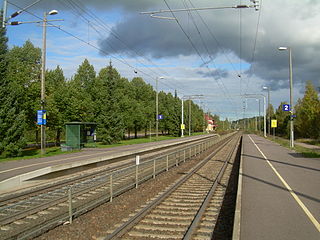
The Herrala railway station is located in Hollola, Finland, in the village and urban area of Herrala. It is located along the Riihimäki–Lahti line, and its neighboring stations are Järvelä in the west and Lahti in the east.

























